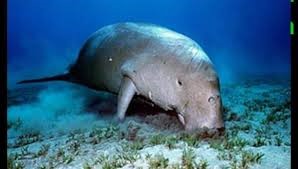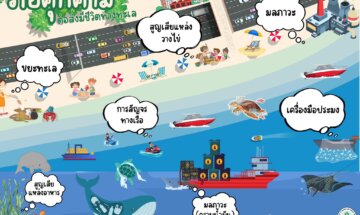
Dugongs are mammals that live in the sea. It is believed that dugongs used to live priory on land and its ancestor is closed to the ancestor of elephants. For about 55 million years ago, dugongs evolved to live in water and never returned to land since then, similar to dolphins and whales.
The dugong species are classified in the Order Sirenia. There are 2 families, namely Dugongidae and Trichechidae. There are entirely 5 species in the world. Currently, there are only 4 species remained and 1 species is extinct.
There is the only one species found in Thailand, Dugong dugon (Muller, 1776), which is from the family of Dugongidae. The distinctive feature of this species is the tail called Fluke.
Dugong (Dugong dugon) has a fusiform body similar to a dolphin. Its body length is approximately 3 meters and its weighs is 200-300 kilograms. The body color of dugong is grayish-pink or grayish-brown; however, the ventral side of dugong is brighter. The dugong has short hairs throughout the body and has large hairs densely around its mouth. Dugong has pairs of small eyes and ears. Its ears are only small openings without auricle. There is a pair of nostrils that close together and inside each nostril has an open close valve. The dugong breathes every 1-2 minutes. There is a pair of flippers on its anterior either side of its body and there is a nipple at each armpit. Their flippers evolved from front legs and inside of the fin consists of 5 fingers. Normally, the manatee swims slowly, with a speed of 1.8-2.2 km/h. They may live alone or in groups.
Dugongs have bones that are densely structured and heavy. Which is suitable for the lifestyle of dugongs that live on the sea floor. because they eat seagrass as food Dugongs do not have weapons for self-defense. only a large body It has a thick skin which may prevent the danger of being bitten or attacked by other animals such as sharks. When wounded, the blood clots very quickly. The young will live with the mother and rely on the mother as a good shield.
Name of dugong There are many names, namely pigs, dugongs, dugongs, mermaids, sea cows and dugongs. “Datong or dugong” is a common name in Thailand.
The dugong (Dugong) is classified as a preserved and protected wildlife. According to the Wildlife Preservation and Protection Act, B.E. The effect extends to eggs and carcasses. as well as the parts of those animals It is also listed on the list of the Convention on International Trade in Endangered Species of Flora and Fauna (CITES), with dugongs being critically endangered. It is therefore classified on the CITES list, List 1, found mainly in the lower Andaman region. by Trang Province. There is extensive conservation of dugongs. It is the source of the most dugongs in Thailand. The dugong has therefore become a symbol of the province in conservation (flagship species)
Dugong behaviours Begin reproductive age at 9-10 years of age, gestation period 13-14 months, give 1 offspring at a time. The mother dugong will take care of the young for about 2 years and the dugong has a lifespan of about 70 years.
Dugong beaching The proportion of stranding was 83 percent, the cause of most strandings. (about 89 percent) caused by fishing gear especially coastal fishing equipment such as floating nets, as well as fishing-related activities.
reference
http://marinegiscenter.dmcr.go.th/kiosk/km_inner.php
บทความล่าสุด

Kingdom Protista (อาณาจักรโพรทิสตา)

ภัยคุกคามจากสิ่งมีชีวิต


